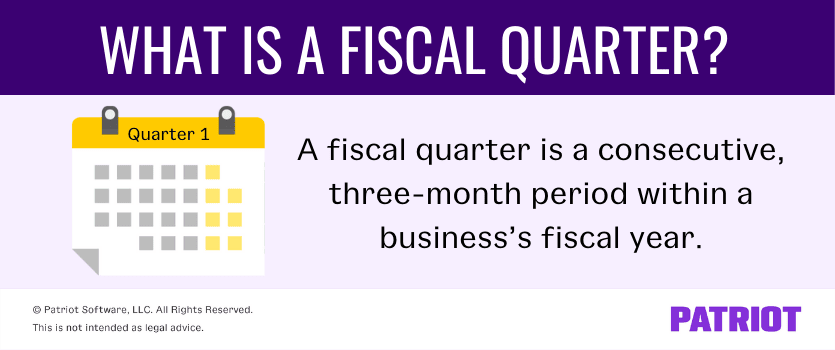Your business’s fiscal quarter plays a role when it comes to things like taxes and finances. But, what is a fiscal quarter? Learn all about fiscal quarters and how to use them in accounting and business.
What’s a fiscal quarter?
A fiscal quarter is a consecutive, three-month period within a business’s fiscal year (or one-fourth of a year).
Publicly-traded companies use four fiscal quarters in a year to release reports at the end of each quarter (called 10-Q reports) with financial statements that outline information for the period. Public companies must file them through the Securities and Exchange Commission (SEC). Companies can use these quarterly reports to track financial performance, make comparisons, and prepare tax documents.
Private companies also use fiscal year quarters when it comes to paying quarterly taxes, setting business goals, etc.
A business quarter may be abbreviated in a variety of different ways. Here’s what it may look like for all four quarters of the year:
- Quarter 1, Q1, quarter one
- Quarter 2, Q2, quarter two
- Quarter 3, Q3, quarter three
- Quarter 4, Q4, quarter four
In business, you may also see a financial quarter abbreviated with the year, such as Q1 2022, Q1/22, or Q122.

Fiscal quarter vs. calendar quarter
So, what’s the difference between a fiscal quarter and calendar quarter? Calendar quarters always correspond to the standard calendar year (aka January 1 – December 31).
Fiscal quarters follow a company’s fiscal year, which can differ from a standard calendar year (which we’ll get more into next). So, a fiscal quarter for one company may be different from another company depending on when their fiscal years are.
Although fiscal years and quarters can vary from business to business, many companies’ fiscal quarters align with the calendar quarters.
Business quarter dates
Fiscal quarter dates can vary depending on your company’s fiscal year.
If a business’s fiscal year aligns with the calendar year, they follow the standard calendar quarters:
- January, February, and March: Q1
- April, May, and June: Q2
- July, August, and September: Q3
- October, November, and December: Q4
Again, not every company’s fiscal quarters align with the calendar year. If this is the case, the company will follow different quarter dates based on their fiscal year. For example, say your business’s fiscal year goes from October – September. Here’s what your non-standard fiscal quarters would look like:
- October, November, December: Q1
- January, February, March: Q2
- April, May, June: Q3
- July, August, September: Q4
Fiscal quarters in business
You can use fiscal quarters in business for a variety of reasons. Here are a few ways fiscal quarters come into play in accounting and business.
Financial reports
When it comes to financial reports, you may need to break them down by each fiscal quarter to see where you stand financially during a certain period. You can use quarterly financial reports to see:
- Business expenses
- Income
- Profits
- Incoming and outgoing money
- Spending habits
You can also use financial reports to pinpoint problem areas and discrepancies and ensure your books balance.
If you use an accountant, they may need you to pull financial reports for the quarter so they can review your finances and file taxes.
Taxes
Fiscal quarters, specifically ones that align with the calendar year, can come into play with certain quarterly taxes and forms for business owners and employers. Here are some examples of quarterly taxes and forms:
- Federal unemployment tax (FUTA)
- Estimated taxes (e.g., self-employed)
- Form 941
If you need to file a form or pay any taxes on a quarterly basis, they typically are due according to the standard quarterly months. For example, Form 941 is due by the last day of the month following the end of the quarter (e.g., form due April 30 for Q1). FUTA tax due quarterly follows the same due dates as Form 941.
The deadline for filing and paying estimated taxes is a little different (e.g., June 15 for Q2), but it still follows the same standard fiscal quarters of the year.
Fiscal Year Quarters Goals
You may also decide to use your company’s fiscal quarters to set goals. For example, if you want to reach a certain goal by the end of Quarter 2, you can look at your fiscal quarter to determine a deadline to reach your goal.
You can also use previous years’ fiscal quarter information to help set goals for the future. Or, you can use past data and compare it to current data to see if your company has improved over time.
This is not intended as legal advice; for more information, please click here.



